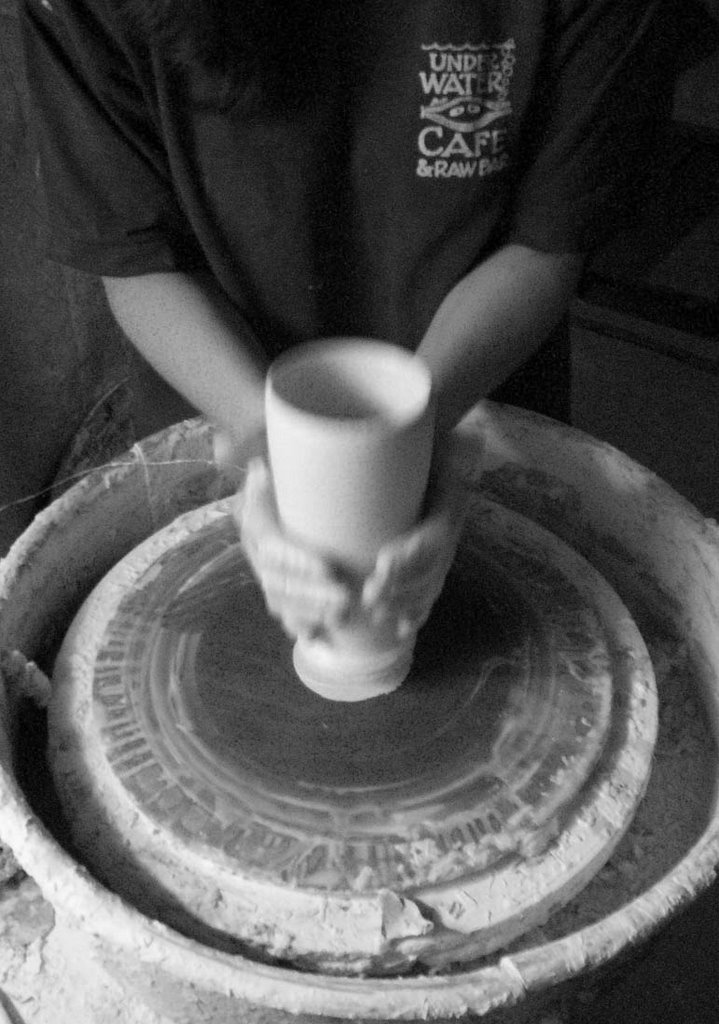11.12.2007
So..it can be done
I got my kiln unloaded today with the pots I vitrified and yes, believe it or not I did manage to glaze them and have them come out. What a miracle! (I truly pulled that one right out of thin air.)
So...I thought what a better technical piece of advice that I should post on my blog than how to glaze something that is vitrified! Most people post about how to do something right and yes....here I am about to post about how to fix a very big flub up if it ever happens to you.
Here's what I did~ I put my bottom two elements on Md. and set the pots in the kiln and heated them up for about 1/2 hour with the lid cracked about 4 inches. Then I put on gloves, got my tongs and started dipping them as fast as I could. You have to keep the pots upside down so all the glaze runs towards the top in stead of the bottom of the pots( where it wants to go...off the pot). What you want is for the heat to dry the glaze on there as fast as it can since the clay has lost all its porous qualities. I would dip about 4 pieces and then go back and do another coat while the piece was still warm. Layer upon layer is the key along with the heat. Then I took a little dish of glaze, put it in the kiln and let some of the water evaporate. This was for the inside of pieces. I would set the glaze piece back in the kiln, warm it up again and then pull it out to brush pretty thick glaze on the inside. Now, I was just doing cups, mugs and small pitchers so this all worked pretty well. I'm sure vitrifying a teapot and trying to salvage that would be very hard because the tongs are the key to not burning your hands. It was all a very long, messy and tedious mistake but I needed the pots for an order and I figured the amount of time it took fooling with them was worth saving the pots.
I know one thing about all this, I'm going really start paying attention the next time I stick a cone in my sitter!
So...I thought what a better technical piece of advice that I should post on my blog than how to glaze something that is vitrified! Most people post about how to do something right and yes....here I am about to post about how to fix a very big flub up if it ever happens to you.
Here's what I did~ I put my bottom two elements on Md. and set the pots in the kiln and heated them up for about 1/2 hour with the lid cracked about 4 inches. Then I put on gloves, got my tongs and started dipping them as fast as I could. You have to keep the pots upside down so all the glaze runs towards the top in stead of the bottom of the pots( where it wants to go...off the pot). What you want is for the heat to dry the glaze on there as fast as it can since the clay has lost all its porous qualities. I would dip about 4 pieces and then go back and do another coat while the piece was still warm. Layer upon layer is the key along with the heat. Then I took a little dish of glaze, put it in the kiln and let some of the water evaporate. This was for the inside of pieces. I would set the glaze piece back in the kiln, warm it up again and then pull it out to brush pretty thick glaze on the inside. Now, I was just doing cups, mugs and small pitchers so this all worked pretty well. I'm sure vitrifying a teapot and trying to salvage that would be very hard because the tongs are the key to not burning your hands. It was all a very long, messy and tedious mistake but I needed the pots for an order and I figured the amount of time it took fooling with them was worth saving the pots.
I know one thing about all this, I'm going really start paying attention the next time I stick a cone in my sitter!
Subscribe to:
Post Comments (Atom)































3 comments:
Wow- good info- I've added glaze to pieces that way... but the whole thing and it worked...hmmm... I am truly impressed!
I learned never to do that in my first pottery class. Guess I had a good teacher.
Well...that teacher you had was all talk!
"Do as I say, not as I do". My young jedi!
Post a Comment